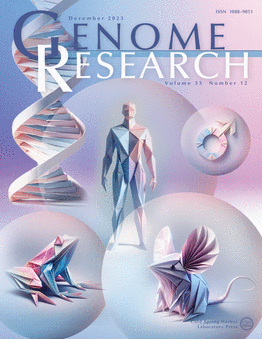遗传对染色质可及性的影响揭示了肝脏基因调控机制和数量性状
IF 6.2
2区 生物学
Q1 BIOCHEMISTRY & MOLECULAR BIOLOGY
引用次数: 0
摘要
染色质可及性定量性状位点(caQTL)研究已经确定了基因表达和代谢性状遗传效应的调控元件。然而,caQTL的发现受到样本量小的限制。在这里,我们绘制了来自138个人类供体的肝组织中的caqtl,并鉴定了35361个调控元件的caqtl,包括由等位基因频率差异驱动的群体特异性caqtl。我们确定了2126个与多个可能协调调节的元件相关的遗传信号。与单元件caqtl相比,协调调节元件将远端元件与靶基因连接起来,更有可能与基因表达相关。我们预测了协调位点上的驱动元件和应答元件,发现驱动元件在关键肝脏调节因子的转录因子结合位点富集。我们在代谢和肝脏性状的667个全基因组关联(GWAS)信号上发现了共定位的caqtl,并用预测的靶基因和中断的转录因子结合位点对这些位点进行了注释。在更大的样本量中,CaQTLs比肝脏表达QTLs (eQTLs)鉴定出的GWAS共定位多三倍,这表明CaQTLs可以检测到eQTLs遗漏的机制。在与TENM2的caQTL和eQTL共定位的GWAS信号中,我们验证了与39个其他元件协调调节的预测驱动元件内变体的调控活性。在另一个位点,我们使用CRISPR干扰验证了RALGPS2的预测增强子,并证明了该增强子内单倍型的等位基因转录效应。这些结果证明了caqtl在GWAS位点上表征调控机制的能力。本文章由计算机程序翻译,如有差异,请以英文原文为准。
Genetic effects on chromatin accessibility uncover mechanisms of liver gene regulation and quantitative traits
Chromatin accessibility quantitative trait locus (caQTL) studies have identified regulatory elements that underlie genetic effects on gene expression and metabolic traits. However, caQTL discovery has been limited by small sample sizes. Here, we mapped caQTLs in liver tissue from 138 human donors and identified caQTLs for 35,361 regulatory elements, including population-specific caQTLs driven by differences in allele frequency across populations. We identified 2,126 genetic signals associated with multiple, presumably coordinately regulated elements. Coordinately regulated elements linked distal elements to target genes and were more likely to be associated with gene expression compared to single-element caQTLs. We predicted driver and response elements at coordinated loci and found that driver elements were enriched for transcription factor binding sites of key liver regulators. We identified colocalized caQTLs at 667 genome-wide association (GWAS) signals for metabolic and liver traits and annotated these loci with predicted target genes and disrupted transcription factor binding sites. CaQTLs identified three-fold more GWAS colocalizations than liver expression QTLs (eQTLs) in a larger sample size, suggesting that caQTLs can detect mechanisms missed by eQTLs. At a GWAS signal colocalized with a caQTL and an eQTL for TENM2, we validated regulatory activity for a variant within a predicted driver element that was coordinately regulated with 39 other elements. At another locus, we validated a predicted enhancer of RALGPS2 using CRISPR interference and demonstrated allelic effects on transcription for a haplotype within this enhancer. These results demonstrate the power of caQTLs to characterize regulatory mechanisms at GWAS loci.
求助全文
通过发布文献求助,成功后即可免费获取论文全文。
去求助
来源期刊

Genome research
生物-生化与分子生物学
CiteScore
12.40
自引率
1.40%
发文量
140
审稿时长
6 months
期刊介绍:
Launched in 1995, Genome Research is an international, continuously published, peer-reviewed journal that focuses on research that provides novel insights into the genome biology of all organisms, including advances in genomic medicine.
Among the topics considered by the journal are genome structure and function, comparative genomics, molecular evolution, genome-scale quantitative and population genetics, proteomics, epigenomics, and systems biology. The journal also features exciting gene discoveries and reports of cutting-edge computational biology and high-throughput methodologies.
New data in these areas are published as research papers, or methods and resource reports that provide novel information on technologies or tools that will be of interest to a broad readership. Complete data sets are presented electronically on the journal''s web site where appropriate. The journal also provides Reviews, Perspectives, and Insight/Outlook articles, which present commentary on the latest advances published both here and elsewhere, placing such progress in its broader biological context.
 求助内容:
求助内容: 应助结果提醒方式:
应助结果提醒方式:


